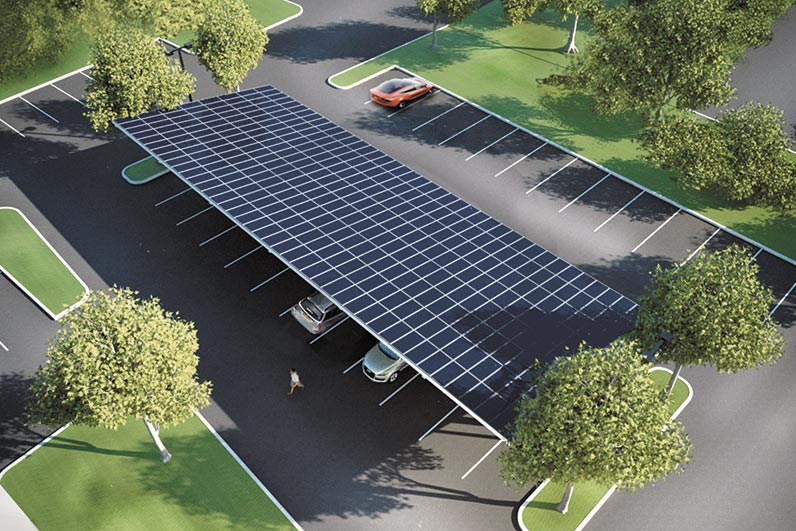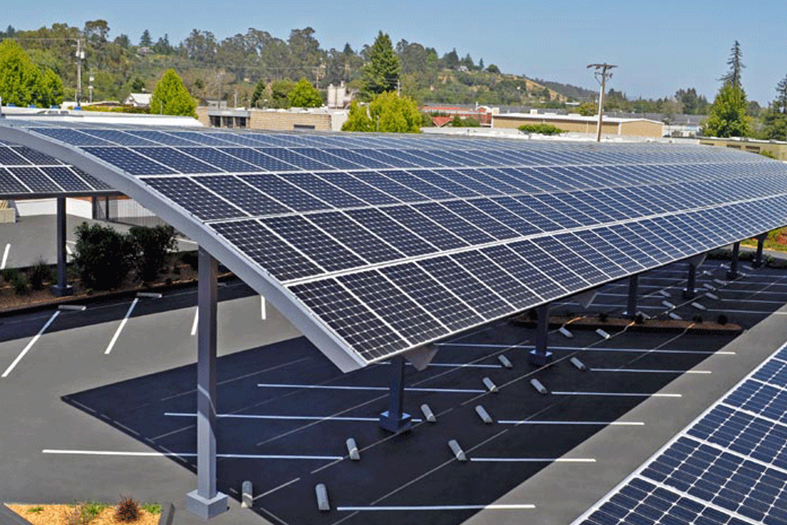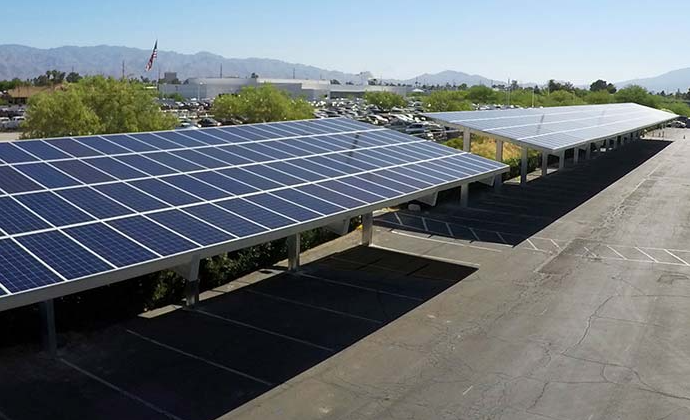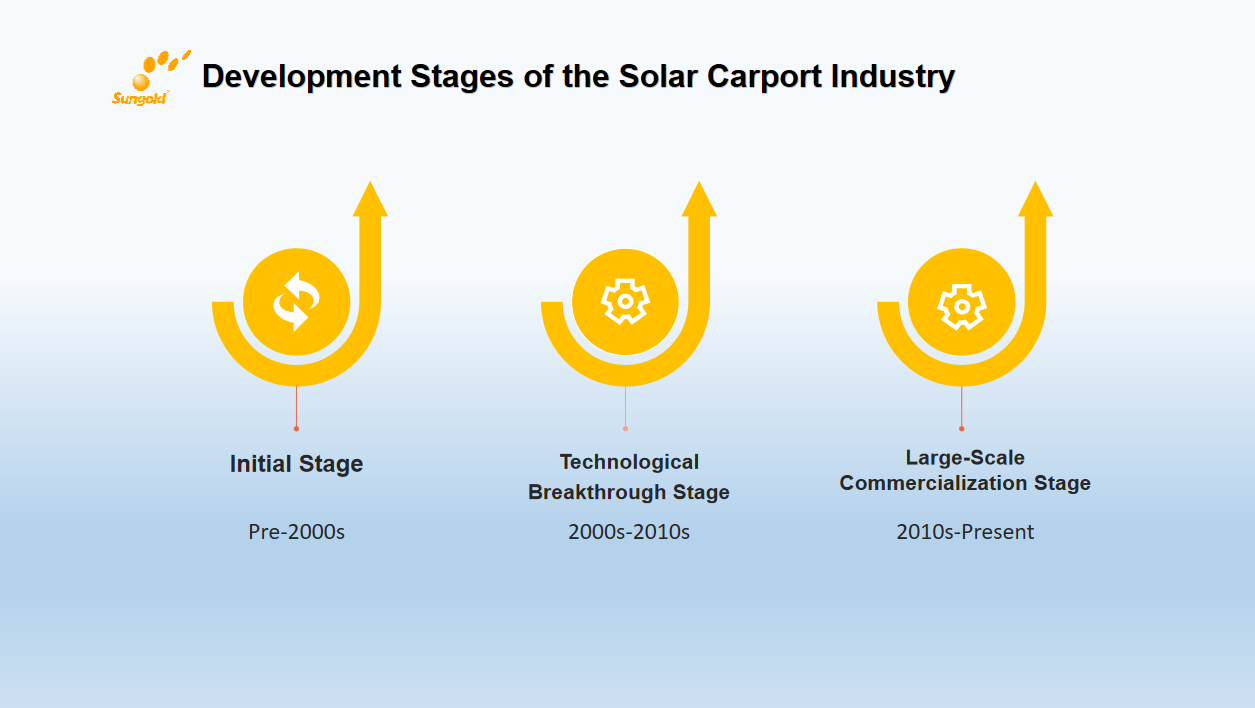With the increasing market share of electric and hybrid vehicles, many businesses, communities, and industrial parks that had originally planned to install parking shelters are now retrofitting them into solar carport.
Solar carport, a straightforward integration of solar panels with existing structures, has gained popularity in recent years. These structures efficiently absorb sunlight, are easy to install, and come at a low cost. They not only make the most of available land but also provide green and sustainable energy, achieving a synergy where the whole is greater than the sum of its parts.
Key Features of Solar Carport
PV Power Generation
Solar panel carports convert sunlight into electricity, which can be used to power charging stations, lighting systems, and other electrical needs.
Vehicle Parking
Solar carports offer shade and rain protection for parked vehicles.
Energy Storage and Internet Connectivity
Some solar carports can be equipped with energy storage systems to store excess electricity generated during the day for use at night or on cloudy days. Additionally, certain carports have internet connectivity for remote monitoring, intelligent management, and data analysis.
External Appearance of Solar Carport
From the outside, a solar panel carport looks like a standard parking shelter, providing protection from the elements for vehicles.
Internal Structure of Solar Carport
Under each carport, there is a junction box where the electricity generated by the solar panels on the carport’s roof is collected. This electricity is then transmitted to inverters, which convert the direct current (DC) into alternating current (AC) before feeding it into the grid, completing the power generation process.
Overall Structure of Solar Carport
Solar carports consist of support structures, arrays of solar panels, lighting systems, control and inverter systems, charging equipment, and lightning protection and grounding systems.
Solar carport support structures vary in design, with common types including single-column single-direction, double-column single-direction, and single-column double-direction configurations.
The scale of Solar Carports
Solar carport projects can vary in size, with larger installations covering more area and accommodating more vehicles. Both commercial and residential solar carports are rapidly expanding, with increased efficiency and improved structural designs.
Advantages of Solar Carports
Lower Installation Cost: Solar carports installed on the ground are typically cheaper and simpler to install compared to rooftop solar systems.
No Additional Land Usage: They utilize existing parking shelter spaces, making efficient use of available real estate.
Charging for Electric and Hybrid Vehicles: Solar carports can charge electric and hybrid vehicles, reducing electricity costs.
Ideal Roof Space: Carport roofs provide unobstructed space for solar panel installation.
Low Maintenance: Solar carports often use durable rigid solar panels that require minimal maintenance and repair.
Disadvantages of Solar Carports
High Construction Costs: Solar carports have higher construction costs compared to traditional carports due to the procurement and installation of solar PV components, support structures, inverters, and other equipment.
Weather Dependency: Solar carport power generation is influenced by weather conditions, resulting in reduced electricity output on cloudy, rainy, or nighttime days, necessitating reliance on the grid for supplementary power.
Grid Dependency: When solar power generation is insufficient, solar carports may need to draw additional electricity from the grid, potentially reducing the proportion of renewable energy used.
How much does a solar carport cost?
The cost of a solar carport depends on the type of solar panels used, the desired electricity generation capacity, and the area covered by the solar panels. In the United States, the cost of solar carports is approximately $3.45 per watt. Larger commercial solar carport installations tend to have lower unit costs compared to residential solar carports. The return on investment and installation value for residential solar carports may be relatively lower due to their smaller scale and higher per-panel costs.
Development Stages of the Solar Carport Industry
- Initial Stage (Pre-2000s): The solar carport industry was in its infancy, with both technology and the market being relatively immature. Limited applications existed due to the constraints of solar power generation technology and high costs.
- Technological Breakthrough and Expansion Stage (2000s-2010s): With advancements in solar PV technology and cost reductions, solar carports gained more attention and experienced some technological breakthroughs. Early solar carport projects were built and promoted, although they were relatively small in scale.
- Large-Scale Commercialization Stage (2010s-Present): In recent years, with government support and growing market demand, the solar carport industry has entered a phase of large-scale commercial development. More businesses and investors have become involved in solar carport projects, driving technological innovation, cost reduction, and increased competitiveness.
Future Outlook for Solar Carport
The application of solar carports is expected to grow steadily with the increasing number of vehicles and the proliferation of carports. The dominant trends for the future include:
Technological Innovation and Cost Reduction
The solar carport industry is committed to enhancing the efficiency and durability of solar PV components while reducing product costs. The introduction and application of new materials and intelligent control systems contribute to the industry’s development.
Market Expansion and Diversified Demand
The solar carport market is expanding to cover various application scenarios, including commercial parking lots, community parking areas, and corporate parking facilities. As environmental awareness grows and renewable energy policies are implemented, the demand for solar carports is expected to increase.
Smart Technology and Internet Integration
The solar carport industry is moving toward smart technology, such as real-time monitoring of solar power generation through intelligent monitoring systems and remote management and troubleshooting. Additionally, some solar carports can interact with facilities like electric vehicle charging stations and energy storage systems, contributing to the concept of an energy internet.
In summary, the combination of new energy vehicles and solar power brings dual benefits to both the environment and the economy, and this trend is expected to continue to grow in the future. With policy support and increasing market demand, the solar carport industry has entered a phase of large-scale commercial development, fostering technological innovation, cost reduction, and improved market competitiveness. As global demand for clean energy continues to rise, the solar carport industry is poised for rapid growth and is expected to become a crucial component of sustainable urban development and smart transportation in the future.















